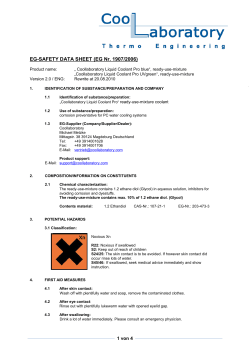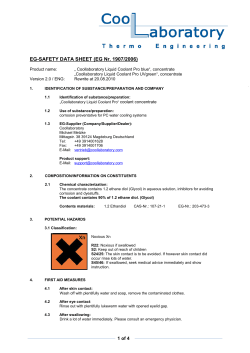
ECOLOGICAL STATUS QUO FOR What is Ecological Classification? 05/04/2013
05/04/2013 What is Ecological Classification? Letaba Catchment NWRCS & RQO Ø EcoClassification consists of three processes: Ø - Present Ecological State (PES) Ø - Ecological Importance Ø - Recommended Ecological Category (REC) Ø The focus in this presentation is on the status quo, i.e. the PES. Ø Information on ecological importance also provided to aid visioning. Ø The PES describes river according to ecological status or health compared to natural conditions. ECOLOGICAL STATUS QUO FOR SELECTED RIVERS AND WETLANDS ECOLOGICAL IMPORTANCE ECOLOGICAL RECOMMENDATIONS 1 What is Ecological Classification? What is Ecological Classification? Ø Ecological status described in terms of Ecological Categories: A – near natural, B – largely natural C – moderately modified D – largely modified E – seriously modified F - critically modified. A A/B B B/C C C/D D D/E E E/F 3 Steps in EcoClassification: Ø Predict the natural condition (the “A”). Ø Evaluate human impacts & describe how ecology changed. (Present Ecological State). Ø Identify whether changes are flow, non-flow or quality. Ø Determine the Ecological Importance and Sensitivity. Ø Derive a Recommended Ecological Category (maintain or improve the PES) F 1 05/04/2013 EVALUATION PESEIS PROJECT: RESULTS & INFORMATION Ø Undertaken for 75 SQ reaches. Ø Desktop PES evaluation & info available. Ø Desktop EI-ES results available. Ø During this study, key non-flow, flow, water quality impacts identified. Ø PESEIS information also extended with additional information in a master Excel Spreadsheet Ø All NFEPAs evaluated and compared with PESEIS results – incorporated where relevant. SQ Number B81D-00246 River Thabina Numbers for NFEPA and used by DWA for PESEIS Instream Habitat continuity modification 2 Consider barriers Riparian zone continuity modification 3 Consider areas of riparian veg that has been removed. Instream habitat modification activities 3 Lack of flow, sedimentation, phys chem problems, bulldozing etc Riparian zone modification activities 3 Alien vegetation, agriculture, veg removal. Flow modification 2 Dams, abstraction, etc Phys-chem modification 2 - Return flows, sewage, urban etc Phys chem hot spots Key impact Additional review to identify hotspot, 3 – 5 rating Non-flow : agric & sedimentation PRESENT ECOLOGICAL STATE (PES) D RIVER ECOLOGY – STATUS QUO IUA 1 57% C, 36% D, 1SQ in B. Key impacts forestry and flow modification, sedimentation, alien veg. Moderate EI. IUA 2 Short SQ in mountains – B PES. Rest D. Key impacts sedimentation, agriculture & some flow mod. High EI Median converted to A – F scale IUA 6 C and D. Moderate EI Rural settlements, subsistence agriculture (non-flow impacts) IUA 3 Letaba C & D: Mostly flow related. Nwanedzi D: Agriculture & urbanisation. Letaba High, Nwanedzi Moderate EI. IUA 4 Letaba C & D: Mostly flow related. Moderate EI IUA 5 B PES – private nature reserves. Moderate EI 2 05/04/2013 WETLAND ECOLOGY – STATUS QUO IUA 1 B81A: Mainly seeps B81B: Channelled valley bottom wetlands Broederstroom – wetlands (C). Vegetation removal. Moderate EIS IUA 4 Dominated by channelled valley bottom wetlands, Letaba, thermal springs (C – C/D). Vegetation removal and agric. Moderate EIS IUA8 Mostly C PES. Nonflow impacts, veg removal, trampling, water quality. Moderate EI IUA10 A, B, C PES. Non-flow & water quality. Moderate & High EI RIVER ECOLOGY – STATUS QUO IUA 11 Mostly C PES. All flow related impacts. High EI. IUA9 C & B PES. Water quality and non-flow related impacts. High EI IUA 2 Thabina frequent channelled valley bottom wetlands (D). Vegetation removal and flow. High EIS. IUA 3 High frequency & diversity of wetlands (Letaba & Nwanedzi). Many associated with small dams (D). Vegetation removal & flow. Letaba – High, Nwanedzi -Moderate EIS IUA8 C/D PES. Klein Letaba – priority channelled valley bottom wetlands. Veg removal. Moderate EIS IUA10 C PES. Nsama River has priority wetlands. Veg removal. Moderate EIS IUA 12 A/B PES. Tsende River priority wetlands. Low EIS. IUA 11 B PES. Floodplain wetlands in Letaba. Low EI. IUA 12 All A & B PES. Mostly High EI RECOMMENDED ECOLOGICAL CATEGORY (REC) REC for nodes with high importance and which is not already in a B or higher PES: IUA9 C/D. Klein Letaba – priority wetlands, incl thermal springs. Veg removal. Moderate EIS IUA7 D PES. High density & frequency of channelled valley bottom wetlands. Veg removal, agric, overgrazing. Some flow impacts. Moderate EIS. IUA7 Mostly D PES. Mixture of flow, quality and impacts due to extensive agriculture. Moderate EI. Ø 2 nodes must be improved by means of non-flow mitigation. Ø 19 nodes must be improved by means of improved flows. WETLAND ECOLOGY – STATUS QUO 3 05/04/2013 Biophysical nodes 4
© Copyright 2025

















